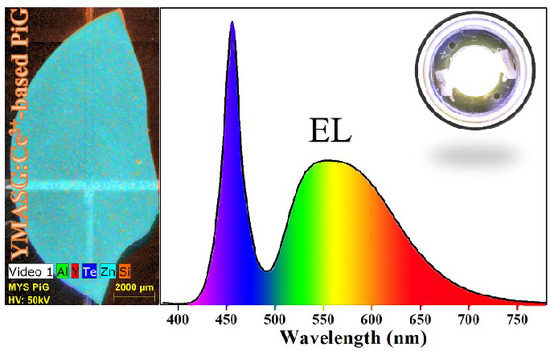Chromaticity-Tunable and Thermal Stable Phosphor-in-Glass Inorganic Color Converter for High Power Warm w-LEDs
Abstract
:1. Introduction
2. Experimental
2.1. Sample Preparation
2.2. Characterizations
3. Results and Discussion
3.1. Phase Analysis
3.2. LuminescentProperties of YMASG:xCe3+
3.3. Microstructure and Luminescence Properties of the PiG Sample
3.4. The Performance of the PiG-Based LEDs
4. Conclusions
Supplementary Materials
Author Contributions
Funding
Conflicts of Interest
References
- Fujita, S.; Yoshihara, S.; Sakamoto, A.; Yamamoto, S.; Tanabe, S. YAG glass-ceramic phosphor for white LED (I): Background and development. In Proceedings of the Fifth International Conference on Solid State Lighting, San Diego, CA, USA, 14 September 2005. [Google Scholar]
- Huang, J.; Hu, X.L.; Shen, J.J.; Wu, D.L.; Yin, C.F.; Xiang, R.; Yang, C.; Liang, X.J.; Xiang, W.D. Facile synthesis of a thermally stable Ce3+:Y3Al5O12 phosphor-in-glass for white LEDs. CrystEngComm 2015, 17, 7079–7085. [Google Scholar] [CrossRef]
- Lee, J.S.; Unithrattil, S.; Kim, S.; Lee, I.J.; Lee, H.; Im, W.B. Robust moisture and thermally stable phosphor glass plate for highly unstable sulfide phosphors in high-power white light-emitting diodes. Opt. Lett. 2013, 38, 3298–3300. [Google Scholar] [CrossRef] [PubMed]
- Zhang, R.; Wang, B.Y.; Zhu, W.F.; Li, C.J.; Wang, H. Preparation and luminescent performances of transparent screen-printed Ce3+:Y3Al5O12 phosphors-in-glass thick films for remote white LEDs. J. Alloy Compd. 2017, 720, 340–344. [Google Scholar] [CrossRef]
- Zhang, X.J.; Yu, J.B.; Wang, J.; Zhu, C.B.; Zhang, J.H.; Zou, R.; Lei, B.F.; Liu, Y.L. Facile preparation and ultrastable performance of single component white-lighting emitting phosphor-in-glass used for high power warm white LEDs. ACS Appl. Mater. Interfaces 2015, 7, 28122–28127. [Google Scholar] [CrossRef] [PubMed]
- Zhong, J.S.; Chen, D.Q.; Zhou, Y.; Wan, Z.Y.; Ding, M.Y.; Ji, Z.G. Stable and chromaticity-tunable phosphor-in-glass inorganic colorconverter for high-power warm white lighting-emitting diode. J. Eur. Ceram. Soc. 2016, 36, 1705–1713. [Google Scholar] [CrossRef]
- Zhang, R.; Lin, H.; Yu, Y.L.; Chen, D.Q.; Xu, J.; Wang, Y.S. A new-generation color converter for high-power white LED: Transparent Ce3+:YAG phosphor-in-glass. Laser Photonics Rev. 2014, 8, 158–164. [Google Scholar] [CrossRef]
- Denault, K.A.; Gerorge, N.C.; Paden, S.R.; Brinkley, S.; Mikhailovsky, A.A.; Neuefeind, J.; DenBaars, S.P.; Seshardri, R. A green-yellow emitting oxyfluoride solid solution phosphor Sr2Ba(AlO4F)1−x(SiO5)x:Ce3+ for thermally stable, high color rendition solid state white lighting. J. Mater. Chem. 2012, 22, 18204–18213. [Google Scholar] [CrossRef]
- Han, J.Y.; Im, W.B.; Lee, G.Y.; Jeon, D.Y. Near UV-pumped yellow-emitting Eu2+-doped Na3K(Si1−xAlx)8O16±δ phosphor for white-emitting LEDs. J. Mater. Chem. 2012, 22, 8739–8798. [Google Scholar] [CrossRef]
- Lee, Y.K.; Lee, J.S.; Heo, J.; Im, W.B.; Chung, W.J. Phosphor in glasses with Pb-free silicate glass powders as robust color-converting materials for white LED applications. Opt. Lett. 2012, 37, 3276–3278. [Google Scholar] [CrossRef] [PubMed]
- Zhang, X.J.; Wang, J.; Huang, L.; Pan, F.J.; Chen, Y.; Lei, B.F.; Peng, M.Y.; Wu, M.M. Tunable luminescent properties and concentration-dependent, site-preferable distribution of Eu2+ ions in silicate glass for whie LEDs applications. ACS Appl. Mater. Interfaces 2015, 18, 10044–10054. [Google Scholar] [CrossRef] [PubMed]
- Wang, B.; Lin, H.; Huang, F.; Xu, J.; Chen, H.; Lin, Z.B.; Wang, Y.S. Non-rare-earth BaMgAl10−2xO17:xMn4+,xMg2+: A narrow bandred phosphor for use as a high-power warm w-LED. Chem. Mater. 2016, 28, 3515–3524. [Google Scholar] [CrossRef]
- Wang, B.; Lin, H.; Xu, J.; Chen, H.; Wang, Y.S. CaMg2Al16O27:Mn4+-based red phosphor: Apotential color converter for high-powered warm W-LED. ACS Appl. Mater. Interfaces 2014, 6, 22905–22913. [Google Scholar] [CrossRef] [PubMed]
- Yoder, H.S.; Keith, M.L. Complete substitution of aluminum for silicon: The system (MnO)3Al2O3(SiO2)3—(Y2O3)3(Al2O3)5. Geol. Soc. Am. Bull. 1950, 61, 1516–1517. [Google Scholar]
- Jiao, M.M.; Jia, Y.C.; Lu, W.; Lv, W.Z.; Zhao, Q.; Shao, B.Q.; You, H.P. Structure and photoluminescence properties of novel Ca2NaSiO4F:Re (Re = Eu2+,Ce3+,Tb3+) phosphors with energy transfer for white emitting LEDs. J. Mater. Chem. C 2014, 2, 4304–4311. [Google Scholar] [CrossRef]
- Wang, B.; Lin, H.; Yu, Y.L.; Chen, D.Q.; Zhang, R.; Xu, J.; Wang, Y.S. Ce3+/Pr3+:YAGG:along persistent phosphor activated by blue-light. J. Am. Ceram. Soc. 2014, 97, 2539–2545. [Google Scholar] [CrossRef]
- Atuchin, V.V.; Beisel, N.F.; Galashov, E.N.; Mandrik, E.M.; Molokeev, M.S.; Yelisseyev, A.P.; Yusuf, A.A.; Xia, Z.G. Pressure-stimluated synthesis and luminescence properties of microcrystalline (Lu,Y)3Al5O12:Ce3+ garnet phosphors. ACS Appl. Mater. Interfaces 2015, 7, 26235–26243. [Google Scholar] [CrossRef] [PubMed]
- Ji, H.P.; Wang, L.; Molokeev, M.S.; Hirosaki, N.; Xie, R.J.; Huang, Z.H.; Xia, Z.G.; Kate, O.M.; Liu, L.H.; Atuchin, V.V. Strucure evolution and photoluminescence of Lu3(Al,Mg)2(Al,Si)3O12:Ce3+ phosphors: New yellow-color converters for blue LED-driven solid state lighting. J. Mater. Chem. C 2016, 4, 6855–6863. [Google Scholar] [CrossRef]
- Pan, Z.F.; Li, W.Q.; Xu, Y.; Hu, Q.S.; Zheng, Y.F. Structure and redshift of Ce3+ emission in anisotropically expanded garnet phosphor MgY2Al4SiO12:Ce3+. RSC Adv. 2016, 6, 20458–20466. [Google Scholar] [CrossRef]
- Chen, L.; Chen, X.L.; Liu, F.Y.; Chen, H.H.; Wang, H.; Zhao, E.L.; Jiang, Y.; Chan, T.S.; Wang, C.H.; Zhang, W.H.; et al. Charge deformation and orbital hybridization: Intrinsic mechanismson tunable chromaticity of Y3Al5O12:Ce3+ luminescence by doping Gd3+ for warm white LEDs. Sci. Rep. 2015, 5, 11514. [Google Scholar] [CrossRef] [PubMed]
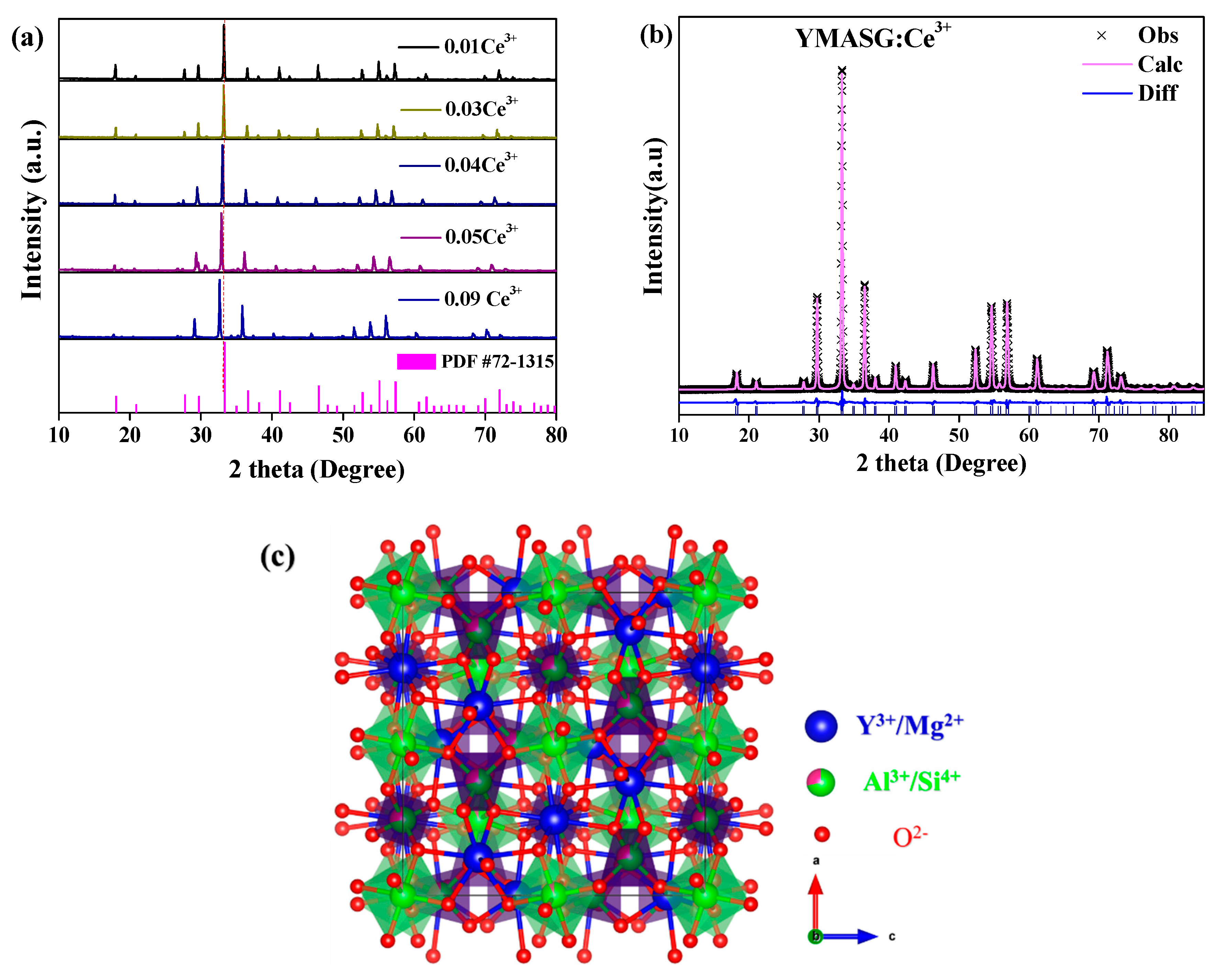
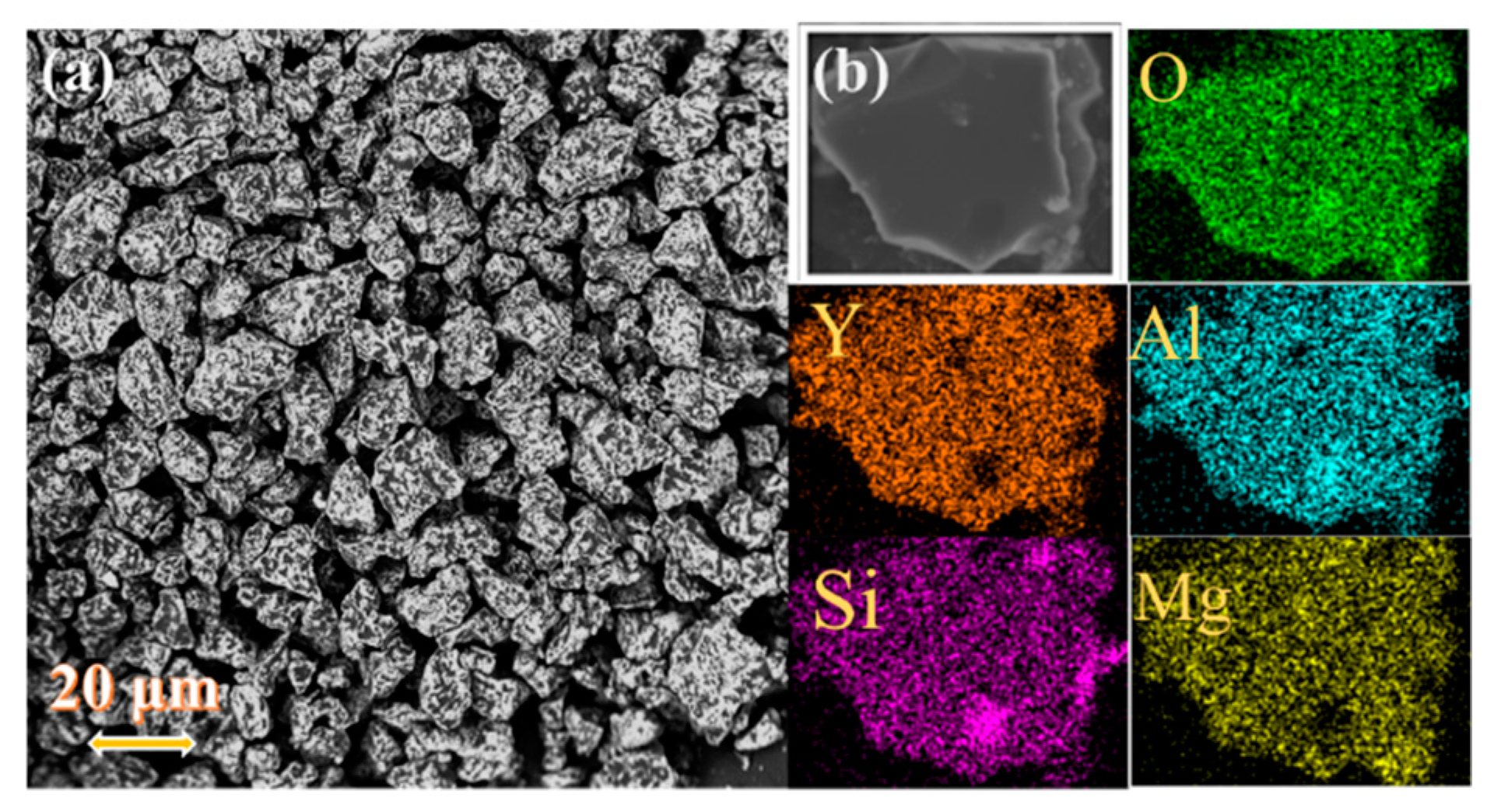
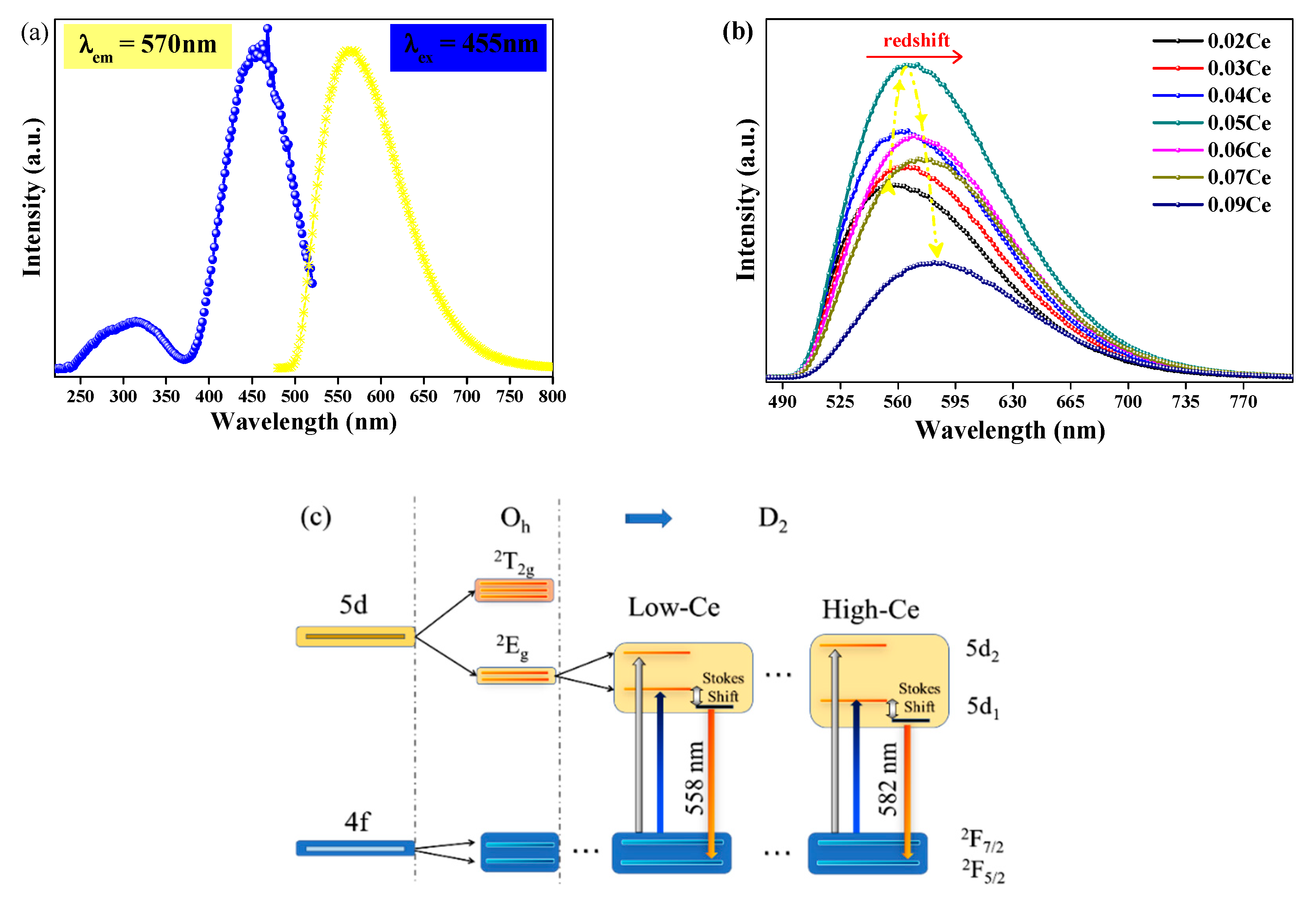
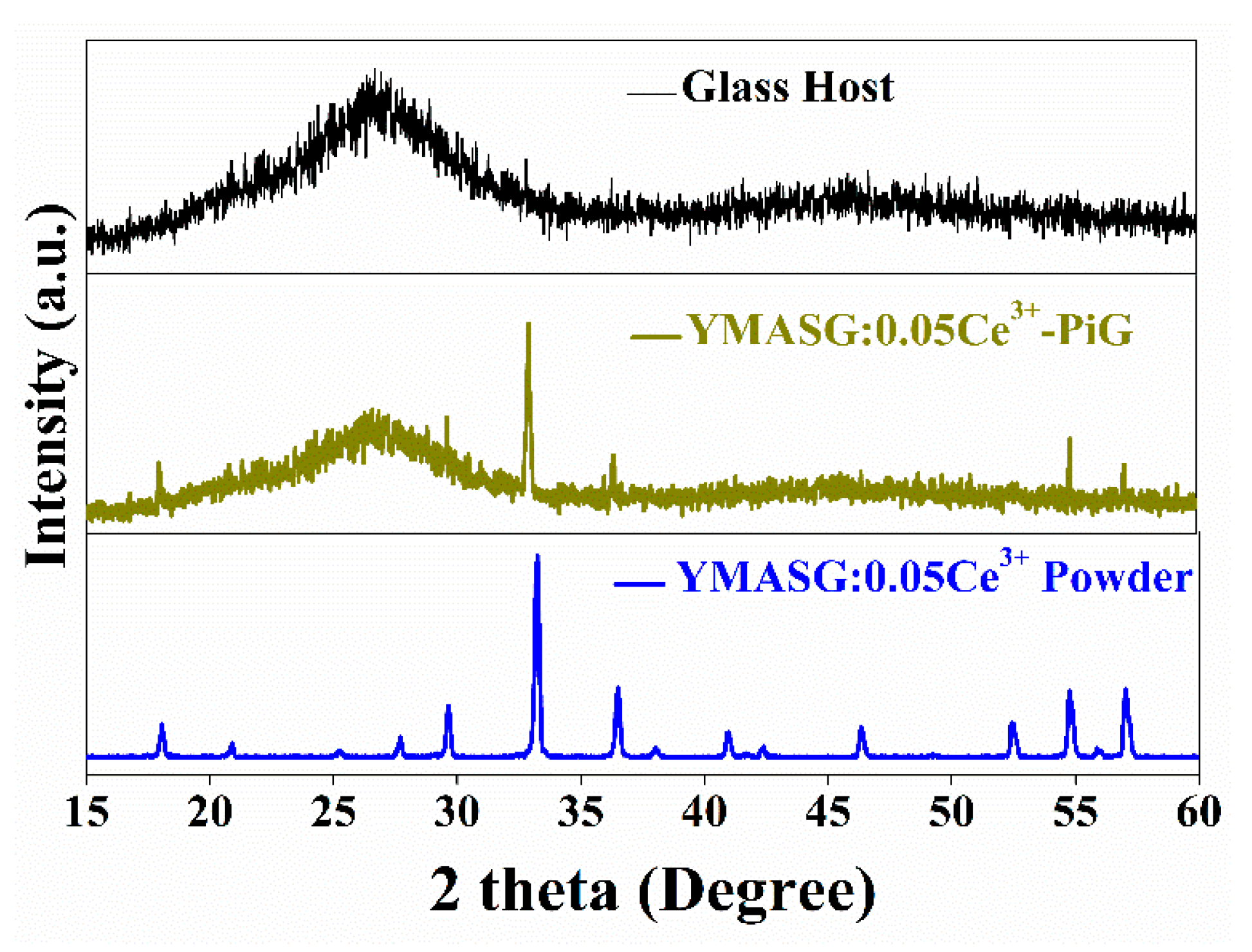
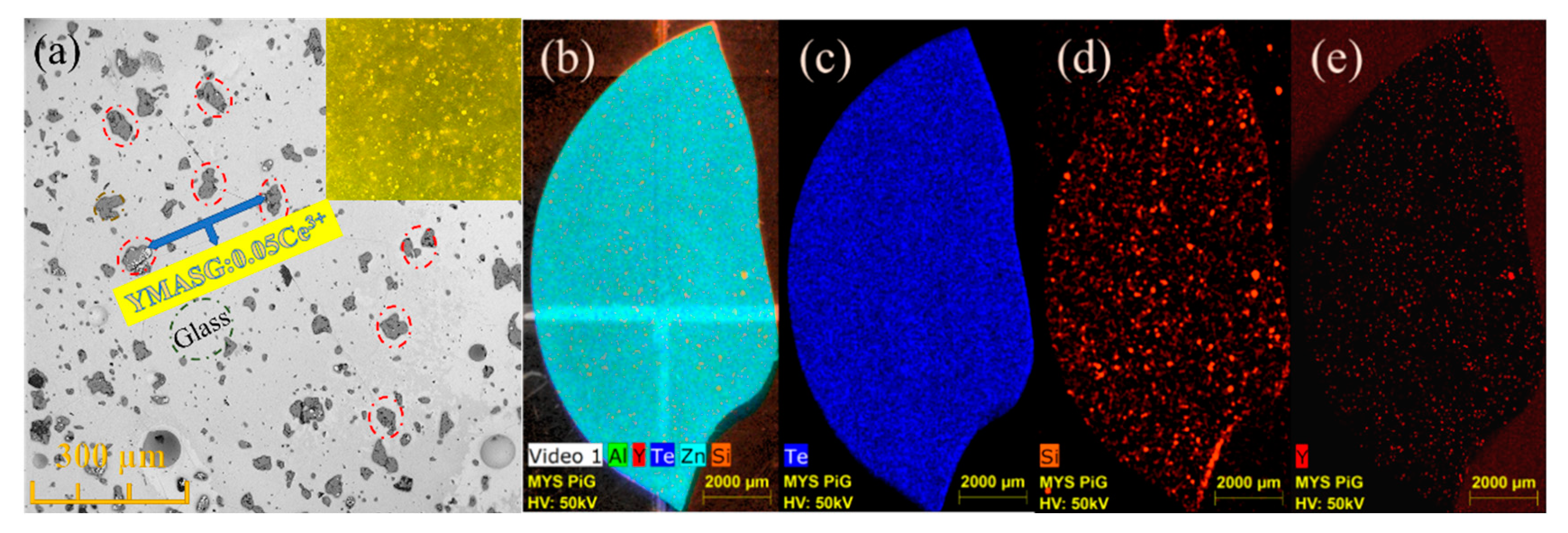
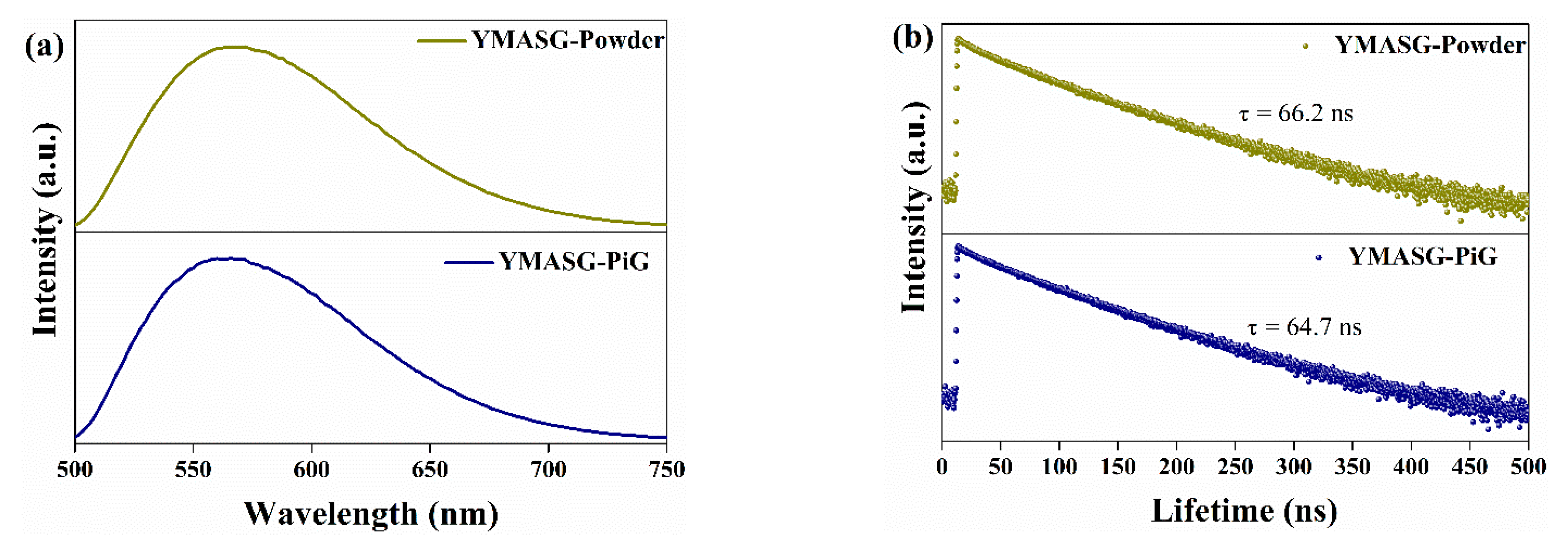
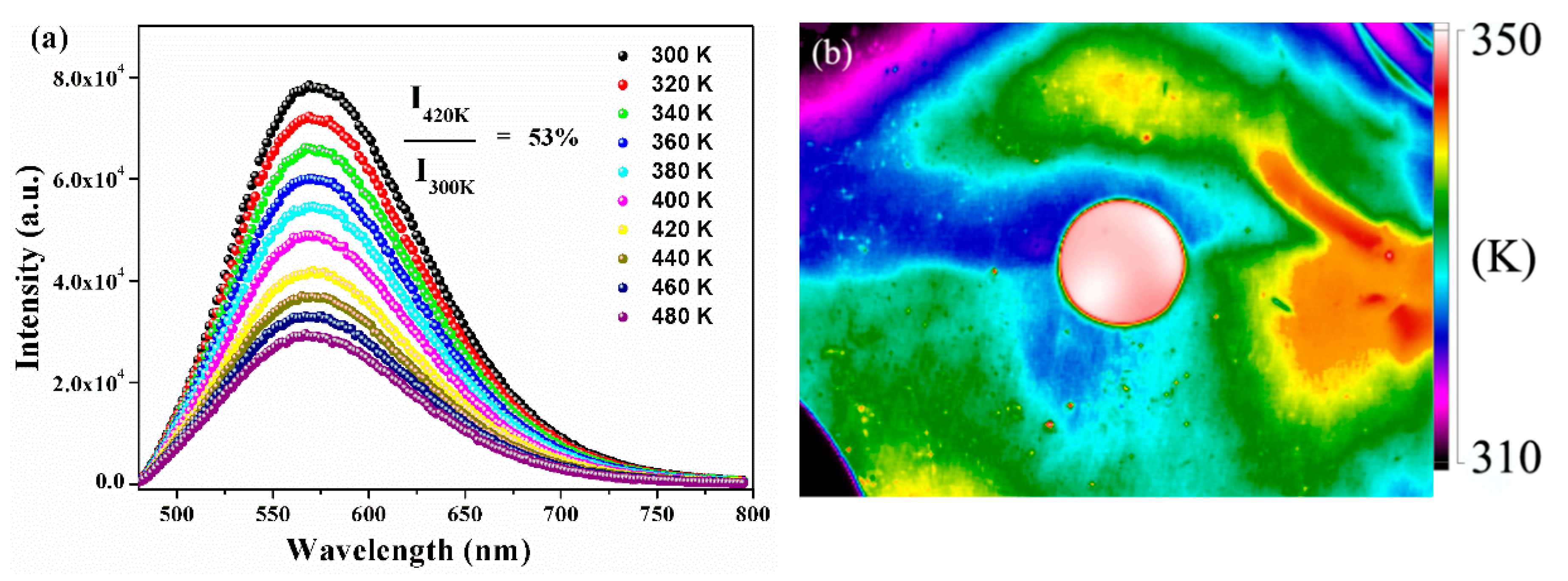
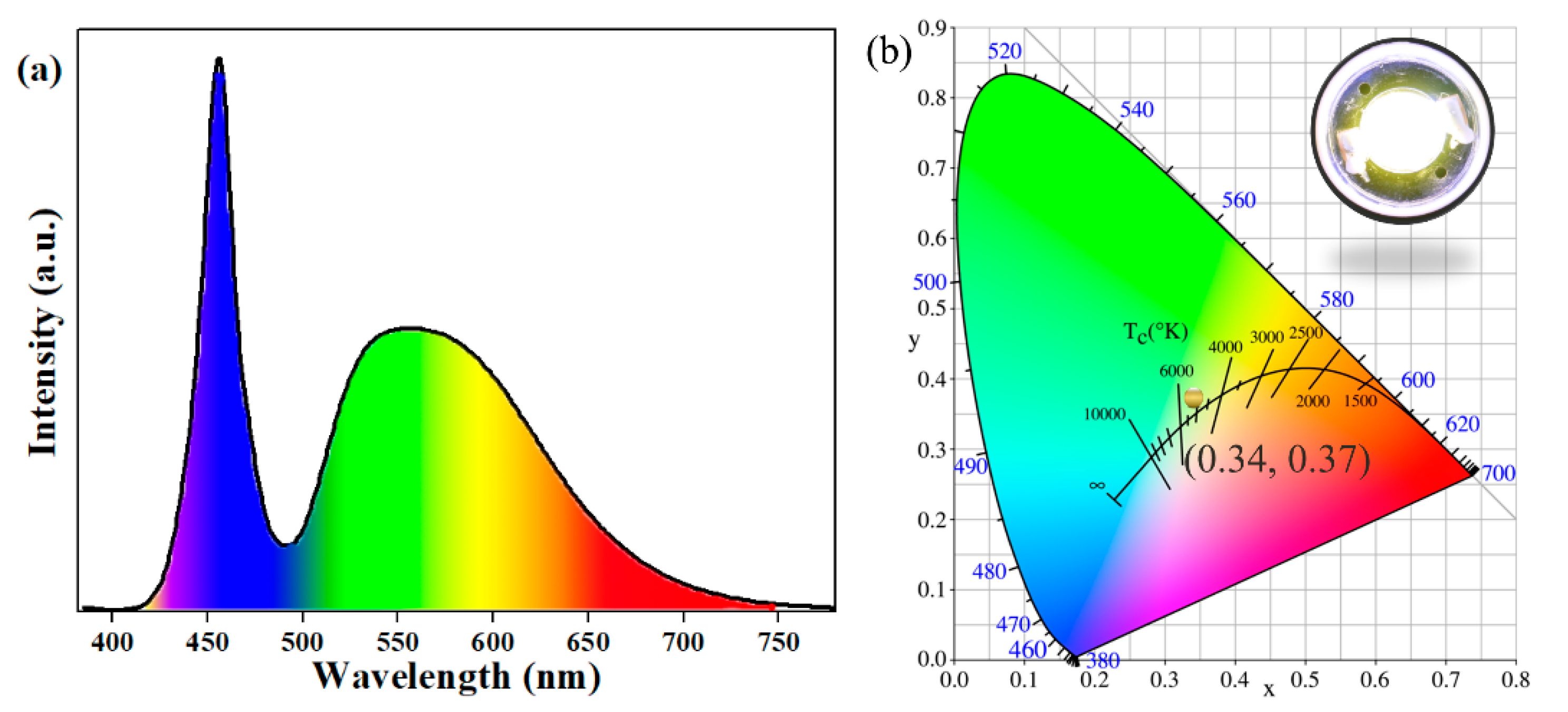
| Formula | Y1.95Mg2Al2Si2O12:0.05Ce3+ |
|---|---|
| Crystal System | cubic |
| Space Group | Ia-3d |
| a = b = c/Å | 11.94 |
| Volume/Å3 | 1702.1 |
| Rp (%) | 10.03 |
| Rwp (%) | 7.62 |
© 2018 by the authors. Licensee MDPI, Basel, Switzerland. This article is an open access article distributed under the terms and conditions of the Creative Commons Attribution (CC BY) license (http://creativecommons.org/licenses/by/4.0/).
Share and Cite
Chen, Z.; Wang, B.; Li, X.; Huang, D.; Sun, H.; Zeng, Q. Chromaticity-Tunable and Thermal Stable Phosphor-in-Glass Inorganic Color Converter for High Power Warm w-LEDs. Materials 2018, 11, 1792. https://doi.org/10.3390/ma11101792
Chen Z, Wang B, Li X, Huang D, Sun H, Zeng Q. Chromaticity-Tunable and Thermal Stable Phosphor-in-Glass Inorganic Color Converter for High Power Warm w-LEDs. Materials. 2018; 11(10):1792. https://doi.org/10.3390/ma11101792
Chicago/Turabian StyleChen, Zikun, Bo Wang, Xiaoshuang Li, Dayu Huang, Hongyang Sun, and Qingguang Zeng. 2018. "Chromaticity-Tunable and Thermal Stable Phosphor-in-Glass Inorganic Color Converter for High Power Warm w-LEDs" Materials 11, no. 10: 1792. https://doi.org/10.3390/ma11101792
APA StyleChen, Z., Wang, B., Li, X., Huang, D., Sun, H., & Zeng, Q. (2018). Chromaticity-Tunable and Thermal Stable Phosphor-in-Glass Inorganic Color Converter for High Power Warm w-LEDs. Materials, 11(10), 1792. https://doi.org/10.3390/ma11101792




